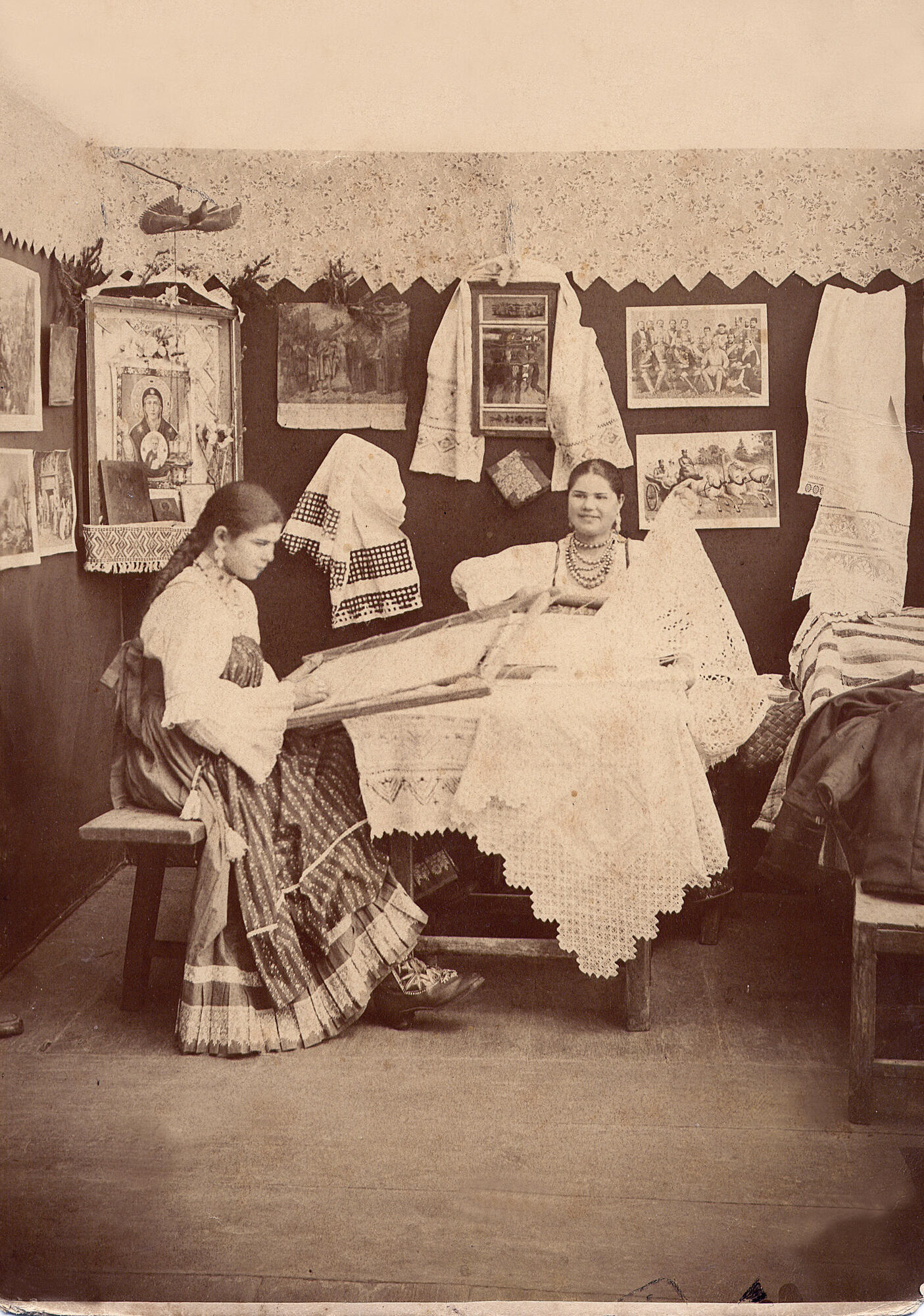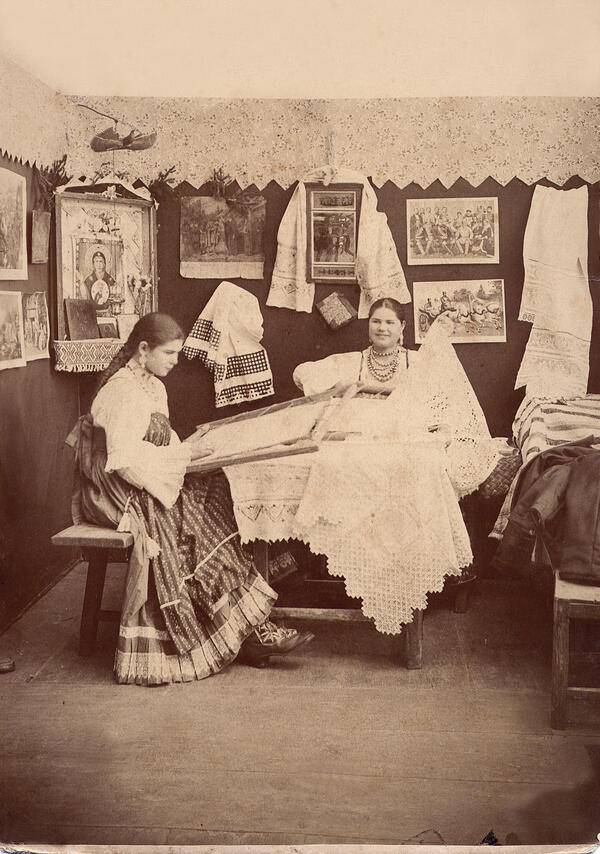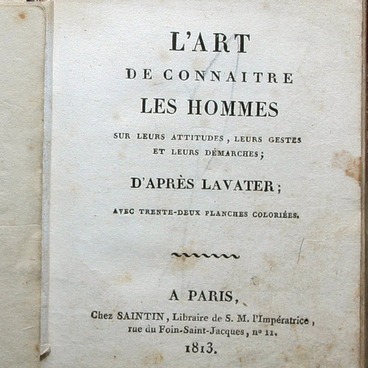The photograph of the embroidery girls was taken for the World’s Columbian Exposition in Chicago in 1893. The works of the craftswomen from the Shushary estate of the Boratynskiy family and other neighboring villages were a great success and were awarded the medal.
Olga Boratynskaya (1844-1918), the daughter-in-law of the poet Evgeniy Boratynskiy, recalled: “In 1893 I sent peasant works to the exhibition in Chicago through Kazan county council and received from there a positive review and bronze medal”.
The poet’s granddaughter Ksenia Alekseeva in her book ‘My Memories’ described the history of this peasant guild as follows: ‘Back at the time mother (Olga Boratynskaya, née Kazem-Bek, - editor’s note)… began distributing handicrafts. The main branch was embroidery on finger loop cloth… Peasant women began to flock from distant villages, motivated by good wages. My mother’s diversified the patterns more and more. Orders began to arrive from Moscow and Petersburg. Mother sent some of the best items to an exhibition in Paris. These works received commendation and the orders started coming from Paris as well. These works were exhibited in many places, both in Russia and abroad (in Nizhny Novgorod, Kazan and in Chicago). Seeing as the business goes well, mother organized the guild which united all the workers. Here are the names of the villages that I remember: Shushary, Kaymary, Tura, Bimeri, Momonino, Usady’.
The guild lasted up to the Revolution of 1917. Its creator Olga Boratynskaya was the daughter-in-law of the poet Yevgeny Boratynskiy. She recalled that ‘In 1893 I sent peasant works to the exhibition in Chicago through Kazan county council and received from there a positive review and bronze medal’.
A feature-story ‘The City of Kazan. 1893’ informed that ‘Kazan citizens demonstrate increased participation in exhibitions, including foreign exhibitions’.
Women’s work was particularly important in this story. For the exhibition in Chicago, an extensive collection of arts and crafts created by women was collected. A prominent place in it was occupied by old and modern women’s costumes - including Tatar, Chuvash, Cheremiss and Mordovian. Also, some items created by the masters of furriery and Tatar scull-cap craft were sent to the exhibition. After the exhibition in Chicago, the photograph was exhibited along with the embroidery made by the girls at exhibitions in Nizhny Novgorod and Kazan.
Olga Boratynskaya (1844-1918), the daughter-in-law of the poet Evgeniy Boratynskiy, recalled: “In 1893 I sent peasant works to the exhibition in Chicago through Kazan county council and received from there a positive review and bronze medal”.
The poet’s granddaughter Ksenia Alekseeva in her book ‘My Memories’ described the history of this peasant guild as follows: ‘Back at the time mother (Olga Boratynskaya, née Kazem-Bek, - editor’s note)… began distributing handicrafts. The main branch was embroidery on finger loop cloth… Peasant women began to flock from distant villages, motivated by good wages. My mother’s diversified the patterns more and more. Orders began to arrive from Moscow and Petersburg. Mother sent some of the best items to an exhibition in Paris. These works received commendation and the orders started coming from Paris as well. These works were exhibited in many places, both in Russia and abroad (in Nizhny Novgorod, Kazan and in Chicago). Seeing as the business goes well, mother organized the guild which united all the workers. Here are the names of the villages that I remember: Shushary, Kaymary, Tura, Bimeri, Momonino, Usady’.
The guild lasted up to the Revolution of 1917. Its creator Olga Boratynskaya was the daughter-in-law of the poet Yevgeny Boratynskiy. She recalled that ‘In 1893 I sent peasant works to the exhibition in Chicago through Kazan county council and received from there a positive review and bronze medal’.
A feature-story ‘The City of Kazan. 1893’ informed that ‘Kazan citizens demonstrate increased participation in exhibitions, including foreign exhibitions’.
Women’s work was particularly important in this story. For the exhibition in Chicago, an extensive collection of arts and crafts created by women was collected. A prominent place in it was occupied by old and modern women’s costumes - including Tatar, Chuvash, Cheremiss and Mordovian. Also, some items created by the masters of furriery and Tatar scull-cap craft were sent to the exhibition. After the exhibition in Chicago, the photograph was exhibited along with the embroidery made by the girls at exhibitions in Nizhny Novgorod and Kazan.



